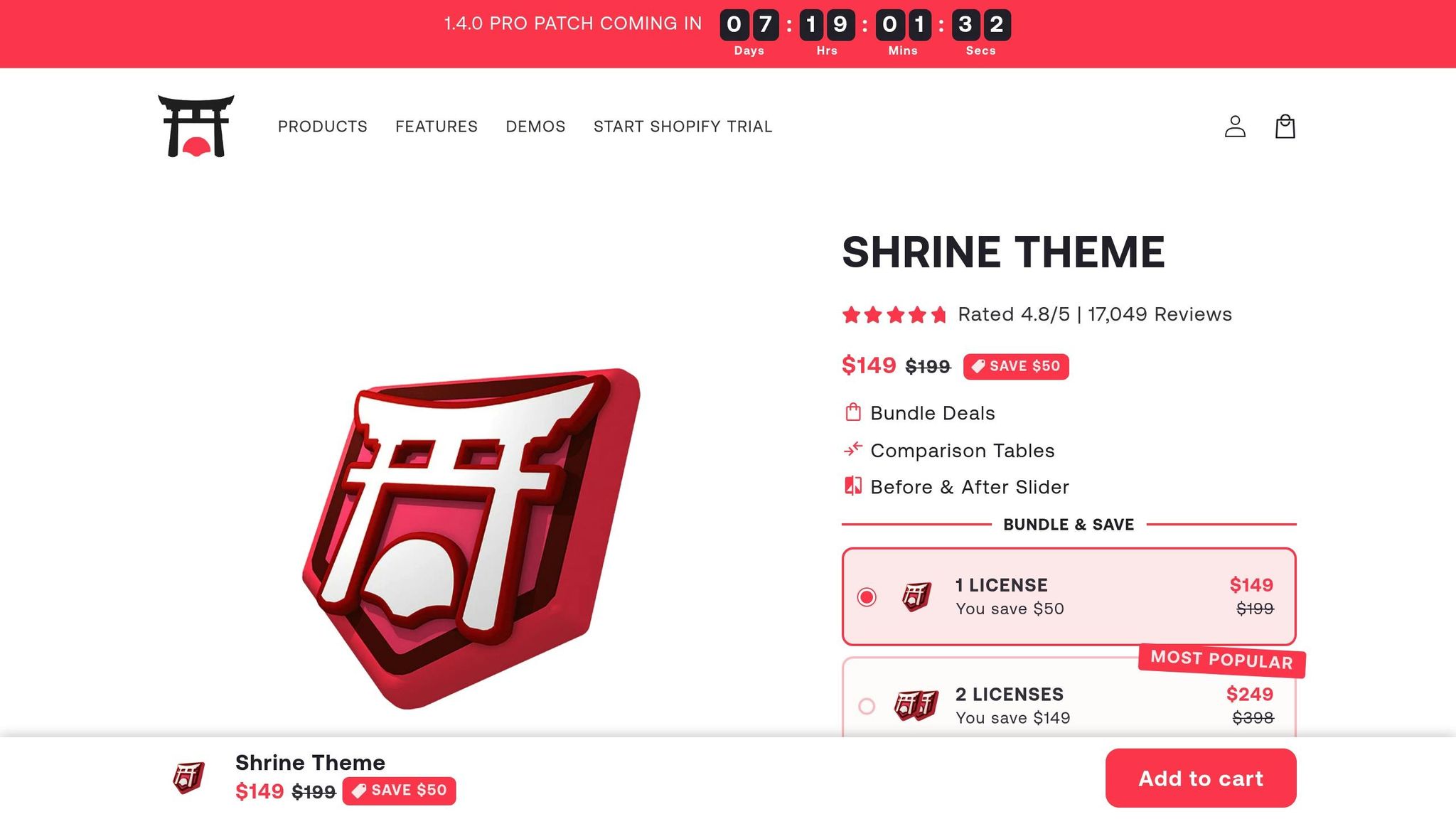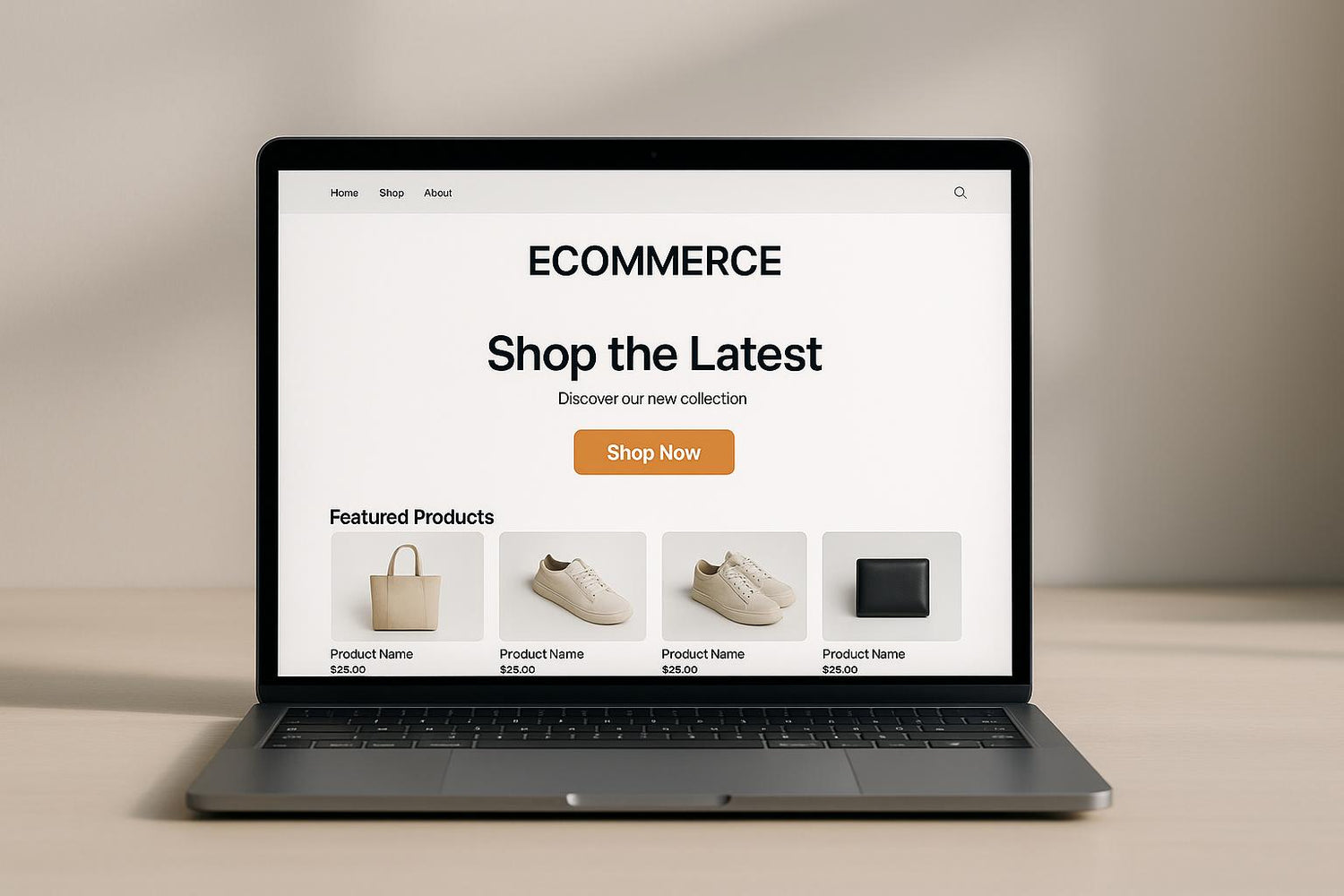Yes, it matters - a lot. Your Shopify theme directly impacts your marketing ROI. A slow, poorly designed theme can waste ad spend by driving visitors away, while a fast, user-friendly theme converts traffic into paying customers. Here’s why:
- Speed is critical: 53% of users leave a site that takes over 3 seconds to load. Every second saved boosts conversions by up to 17%.
- User experience drives trust and sales: 94% of first impressions are based on design. A cluttered or confusing layout kills credibility and conversions.
- Mobile matters: Over 60% of eCommerce traffic is mobile. A slow or unoptimized mobile experience can cut conversions by 20% per second of delay.
- Built-in features save money: Themes like Shrine include tools like reviews, upsells, and urgency timers, reducing reliance on costly third-party apps.
Bottom line: A high-performing theme isn’t just about looks - it’s essential for turning ad clicks into revenue. Investing in speed, design, and functionality pays off with higher conversions and better ROI.
How Theme Performance Drives Conversion Rates
Theme performance isn't just a technical detail - it directly impacts your bottom line. When your site loads quickly and offers a smooth experience, visitors are far more likely to stick around and complete a purchase. On the flip side, slow load times can drive potential customers away in seconds.
The numbers don’t lie. About 50% of customers leave a site if it takes longer than 3 seconds to load. Speed isn't just a luxury; it’s a necessity. Even small improvements can make a big difference. Every second shaved off your load time can boost your conversion rate by 17%. That’s real money left on the table if your site lags.
Speed's Impact on Conversions
Website speed is a major factor in turning visitors into customers. Consider this: pages that loaded in 2.4 seconds had a 1.9% conversion rate. At 3.3 seconds, it dropped to 1.5%, and at 4.2 seconds, it fell below 1%. By 5.7+ seconds, the conversion rate plummeted to just 0.6%. That’s a staggering decline - nearly threefold - simply because of slower load times.
Big-name retailers have proven the stakes. A 1-second improvement in load time can increase conversions by 2%, and even a 100ms improvement can result in a 1% boost. On mobile, the stakes are even higher. Every additional second of load time on mobile can cost you up to 20% in conversions. Worse yet, 53% of mobile users abandon sites that take more than 3 seconds to load. With mobile traffic dominating eCommerce, a sluggish mobile experience can cripple your sales.
"As consumers are becoming more time-poor and attention spans are decreasing, pages that don't load immediately can mean that a customer will refuse to purchase from [that] site." – Daniel Cheung, SEO and Marketing Professional
The results from improving site performance speak volumes. Reducing LCP (Largest Contentful Paint) by 31% can lead to an 8% increase in sales. Rakuten 24, for example, focused on optimizing their Core Web Vitals and achieved a 33.13% increase in conversion rates and a 53.37% boost in revenue per visitor. Similarly, redBus saw a 7% sales increase after improving their website performance.
But speed isn’t the whole story. The design and navigation of your site also play a crucial role in shaping customer behavior.
User Experience Effects on Shopping Behavior
Speed gets visitors through the door, but intuitive design keeps them engaged. A well-thought-out user interface (UI) and user experience (UX) can have a massive impact on conversions. A well-designed UI can increase a website's conversion rate by up to 200%, while enhanced UX design can drive it up by as much as 400%.
Why does this matter so much? Because first impressions count. 94% of first impressions about a website are based on its design, and 75% of a website’s credibility comes from its design. When users land on your site, they’re making split-second judgments about whether they trust you. A fast, clean design builds confidence, while a cluttered, slow site sends them running.
Cart abandonment rates also highlight the importance of user experience. Nearly 70% of shopping carts are abandoned, and poor UX is often to blame. For instance, 18% of users abandon their carts because the checkout process is too long or complicated. Additionally, 38% of users stop engaging with a site if the content or layout is unattractive.
Real-world examples show how design improvements can make a difference. Gymshark simplified their multi-page checkout into a one-click guest flow, resulting in a 33% reduction in cart abandonment. Glossier revamped their product pages with user photos, how-to videos, and a tabbed layout, leading to a 38% increase in mobile conversions and an extra 52 seconds of time spent on each page.
"The user-friendly presentation and quality of content play a crucial role in converting visitors into buyers. A well-thought-out user interface can enhance the conversion rate." – Yevhen Ivliev, Head of UX/UI Department at Promodo
Ultimately, the relationship between theme performance and conversions is about creating a seamless experience. Sites that load in 3 seconds or less see visitors browse 60% more pages, giving you more opportunities to showcase your products and build trust. By prioritizing both speed and design, you’re not only boosting conversions but also maximizing the return on your advertising investments.
How Bad Themes Hurt Marketing Performance
A well-optimized theme can elevate your marketing efforts, but a poorly designed one? It can drain your budget and sabotage your results. When your theme isn't built for performance, every marketing dollar stretches thinner. Not only does it create a frustrating experience for users, but it also inflates costs and cuts into your ROI.
High Bounce Rates from Slow Loading
Slow-loading themes are a silent killer for ad spend. Imagine this: someone clicks on your ad, lands on your site, and... waits. And waits. Chances are, they'll leave before the page even loads. In fact, Google data shows that the likelihood of a bounce increases by 32% when load time jumps from one to three seconds. Push that to over three seconds, and 40% of shoppers will abandon your site entirely.
The numbers are staggering. For pages loading in under three seconds, the average bounce rate is 8%. At four seconds, it leaps to 24%, and by five seconds, it's at 38%. If your page takes a sluggish 10 seconds to load, you could see a bounce rate increase of 123%.
What’s worse? Those visitors who bounce aren’t coming back. Around 80% of users who encounter a slow website won’t return. This is especially concerning for mobile users, where patience is even thinner.
Poor Mobile Performance Problems
Mobile traffic now dominates online shopping, with over 60% of eCommerce browsing happening on smartphones. Yet, mobile users are notoriously impatient. If a mobile page takes longer than three seconds to load, more than half of visitors will bounce. Even a single second of delay can slash conversion rates by 7%.
Themes that aren’t optimized for mobile can make matters worse. Bloated designs, tiny buttons, unreadable text, and cluttered layouts frustrate users, leading to premature exits and wasted ad spend. Bryan Clayton, CEO of GreenPal, learned this the hard way. Before redesigning his site with a mobile-first focus, mobile browser conversions were under 4%. After the revamp? A whopping 82% of users who started the sign-up process completed it on mobile devices and tablets.
A fast, mobile-optimized website isn’t just a nice-to-have; it can double your advertising revenue. Without it, you’re throwing money at ads that lead users to a poor experience, compounding the problem.
Lower Conversions and Wasted Ad Money
A slow or poorly performing theme creates a vicious cycle: higher ad costs, fewer conversions, and dwindling profits. Every second of delay can cut conversion rates by up to 20%. That means you're paying for traffic that doesn’t convert.
Consider this: Amazon found that a mere 100-millisecond delay in page load time reduced sales by 1%. Walmart, on the other hand, saw a 2% boost in conversion rates for every one-second improvement in load speed. These small changes can have massive effects on your bottom line.
But it’s not just about conversion rates. Slow themes can also hurt your organic search rankings, forcing you to rely more on paid ads to drive traffic. On top of that, poor performance erodes trust - 79% of shoppers are less likely to buy from a site that performs poorly. This not only affects immediate sales but also reduces the lifetime value of your customers.
"Search engines reward fast-loading websites with better visibility. Slow performance increases bounce rates, reduces conversions, and drives up ad costs. Addressing speed is not optional - it's fundamental."
- Brett Thomas, founder of Rhino Web Studios
The good news? Companies that prioritize performance see results. Mozilla shaved 2.2 seconds off its page load time and saw a 15.4% spike in organic traffic. Pinterest cut its perceived wait time by 40%, leading to a 15% increase in SEO traffic and a 10% jump in user-generated ad revenue. These examples prove that investing in speed and performance pays off - literally.
Why Shrine Works as a Marketing Tool, Not Just a Theme

Shrine isn't just about aesthetics - it's built to function as a marketing powerhouse that drives conversions. While many Shopify themes focus solely on appearance, Shrine combines speed and integrated features to improve your marketing ROI without the need for costly add-ons. Here's how it delivers results.
Built-in Features That Replace Third-Party Apps
Running a Shopify store often means juggling multiple apps for upsells, bundles, urgency tools, reviews, and advanced cart functionality. These add-ons can easily rack up hundreds of dollars in monthly costs.
Shrine simplifies this by embedding these essential tools directly into the theme. Features like integrated reviews, urgency tools, and optimized layouts save you from the hassle of managing multiple apps while keeping your store running smoothly.
The stats speak for themselves: 95% of customers read reviews before making a purchase, and just five reviews can increase the likelihood of a sale by an impressive 270%. Similarly, popups with countdown timers have been shown to convert 113% better than those without them.
"Shrine Pro Theme is hands down a must-have for any serious e-commerce store...Eliminates the need for many paid apps - I've easily saved over $1,000/year on subscriptions." – Badr-eddine Ouchhida
Trust is another critical factor. Studies show that 61% of customers won't complete a purchase if a site lacks trust logos. Annette Snow, Partner Manager at Stamped, sums it up perfectly:
"We're a lot more leery of pulling out our credit cards when we can't see who we're interacting with. Trust alleviates that. Building social proof through reviews and user-generated content builds trust that converts to sales."
Optimized for Speed and Conversions
When it comes to online shopping, speed is everything. Shrine themes load 15–35% faster than the average Shopify theme, with key pages loading in just 2.6–3.8 seconds and First Contentful Paint (FCP) clocking in at 1.8 seconds. These numbers matter - a one-second improvement in load time can boost conversions by up to 27%.
Mobile performance is just as crucial. With 52% of users less likely to engage with a brand after a poor mobile experience, and 49% holding their phones with one hand, a seamless mobile design is non-negotiable. Even a one-second delay in mobile load times can reduce conversions by 20%.
Shrine’s design is laser-focused on conversions, incorporating features like bundle deals, before-and-after sliders, quantity discounts, cart upsells, and comparison tables. All of these work together seamlessly without slowing down your store.
"Shrine is an all-in-one solution available for a one-time payment, designed to help you grow your eCommerce business. It offers high customization, built-in features like upsells and bundles, and is optimized for fast loading times - all without the need for extra apps or ongoing fees." – Shrine.io
A Perfect Fit for Media Buyers and Growing Stores
For media buyers and rapidly growing eCommerce stores, Shrine Pro offers a tailored solution. It eliminates the need for expensive third-party apps with advanced features designed to maximize efficiency and conversion rates. At a one-time cost of $349, it can save users over $115 per month compared to piecing together similar functionality through separate apps.
Shrine Pro also stands out with 20 customizable cart options - far beyond the six available in the standard theme. These include cart drawer upsells, quantity discount bundles, and trust-building urgency blocks, all designed to function without compromising performance.
The theme is optimized for platforms like Facebook and TikTok Shops, ensuring a mobile-first, touch-friendly experience ideal for fast-paced social media interactions. Its effectiveness is reflected in a strong 4.7/5 rating from over 48,836 reviews. Features such as direct MP4 video uploads and built-in bundle offers further enhance the shopping experience, helping to increase average order value without adding extra monthly costs.
And when Google Ads typically generate $2 in revenue for every $1 spent, even a slight boost in conversion rates can make a noticeable impact on profitability.
Conclusion: Theme Performance Investment for Long-Term Growth
Choosing the right theme isn’t just about aesthetics - it’s a strategic business decision that impacts every dollar you spend on marketing. The numbers speak for themselves: improving load time by just 0.1 seconds can increase eCommerce conversions by 8.4%, while a single second of delay can cut conversions by as much as 20%.
Let’s break it down: if your store brings in $100,000 per month, a one-second delay could cost you $84,000 annually in lost revenue due to poor performance. That’s a significant hit to your bottom line.
Real-world examples highlight the power of prioritizing performance. Laughing Pug Australia saw daily sales skyrocket by 400% within two months of switching to an optimized theme. Jennifer Lay Lash Supplies reported an astonishing 875% boost in conversion rates just three months after optimizing their theme. These success stories show that focusing on theme performance is a game-changer for long-term growth.
Key Points to Remember
Here’s what you should take away:
- Speed builds trust and boosts revenue. Nearly 70% of consumers say page speed directly influences their decision to buy, and 53% of mobile users will leave a page that takes more than three seconds to load. Slow pages don’t just frustrate users - they hurt your brand’s credibility.
- Theme performance impacts all marketing efforts. Whether you’re running ads or growing organically, a fast and responsive theme helps turn clicks into sales.
- Built-in features matter. Themes like Shrine include integrated conversion tools, reducing the need for third-party apps that can slow down your site.
- Optimization is ongoing. Use tools like Google PageSpeed Insights and regularly audit your apps to maintain peak performance and maximize returns.
Ultimately, your theme is either adding to your profits or draining them - it’s that simple. With conversion rates, user experience, and marketing ROI all tied to those critical first seconds of load time, investing in theme performance is one of the smartest moves you can make for sustained eCommerce success.
FAQs
How does the performance of an eCommerce theme impact marketing ROI?
The performance of your eCommerce theme plays a key role in your marketing ROI, directly affecting how well your store turns visitors into paying customers. A theme that loads quickly and is thoughtfully designed can elevate the user experience (UX) and, in turn, drive higher conversion rates. Here’s a striking example: websites that load in just one second can see conversion rates up to 2.5 times higher than those that take five seconds.
Beyond speed, a well-optimized theme minimizes reliance on too many third-party tools, keeping your store efficient and laser-focused on sales. By improving both speed and usability, you not only enhance customer satisfaction but also make your paid advertising efforts more effective. Every dollar spent on ads works harder when your site performs seamlessly. In short, optimizing your theme isn’t just about aesthetics - it’s a smart move for boosting marketing performance and achieving sustainable growth.
How can I improve my Shopify theme's speed and user experience for better conversions?
How to Improve Your Shopify Theme's Speed and User Experience
Enhancing the speed and user experience of your Shopify theme is crucial for driving conversions and improving your store's overall performance. Here are some practical steps to help you get there:
- Select a fast, streamlined theme: Go for themes designed with speed in mind. These themes avoid unnecessary features that can bog down your site, keeping it clean and efficient.
- Optimize your images: Before uploading, compress and resize your images. This ensures they load quickly while still looking sharp and professional.
- Reduce apps and scripts: Uninstall apps you’re not using and limit third-party scripts to only what’s absolutely necessary for your store to function effectively.
By implementing these changes, you’ll create a faster, more enjoyable shopping experience for your customers, which can lead to better load times and higher conversion rates.
Why is mobile optimization important for eCommerce, and how can I make sure my theme works well on mobile devices?
Why Mobile Optimization Matters for eCommerce
These days, most shoppers are glued to their smartphones, using them to browse and make purchases. That means having a mobile-friendly eCommerce site isn't just a nice-to-have - it's essential. A well-optimized mobile site makes shopping easier, reduces frustration, and can directly lead to higher conversion rates. On the flip side, if your site doesn’t work well on mobile, customers are likely to head straight to competitors who offer a smoother experience.
To make your site mobile-friendly, start with a responsive design - this ensures your site adapts perfectly to any screen size. Prioritize fast loading speeds, use compressed images, and make navigation simple and intuitive. Small but impactful features like click-to-call buttons and streamlined menus can make a big difference in how users interact with your site on their phones. And don’t forget to regularly test and update your site to keep up with changing user expectations and maintain top-notch mobile performance.



